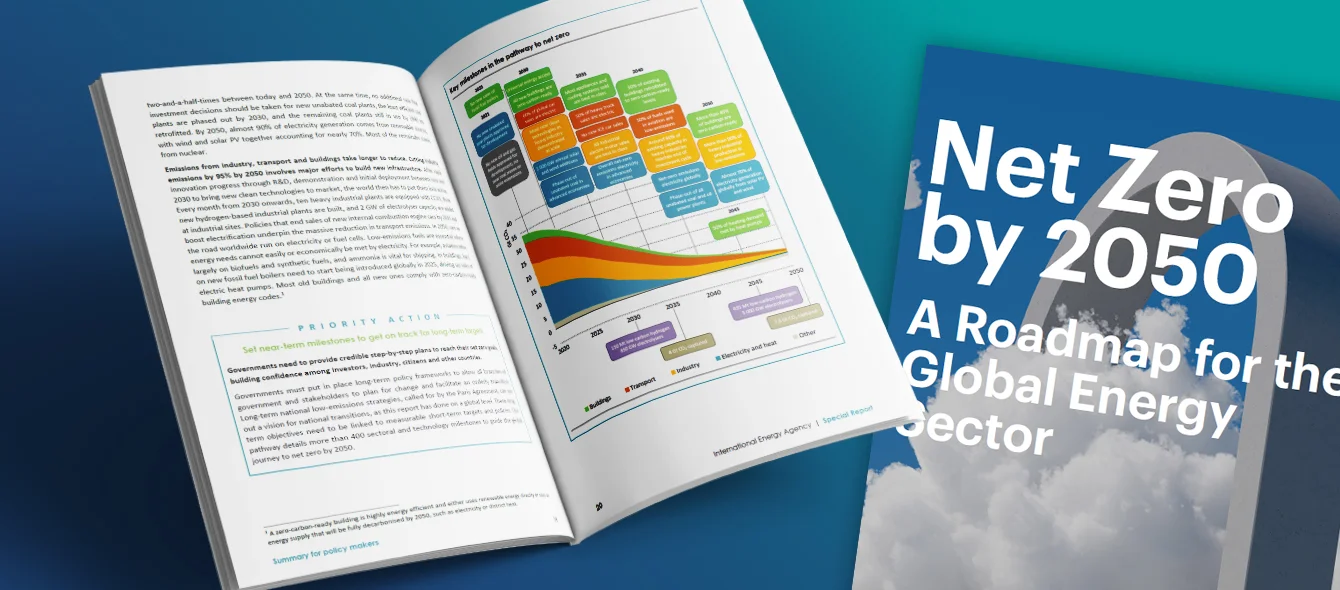The International Energy Agency (IEA) has published “Net Zero by 2050, A Roadmap for the Global Energy Sector”, a report which outlines how the world can reduce its greenhouse gas (GHG) emissions by 2050 and limit the change in global temperatures to 1.5°C. The agency argues that to achieve this ambitious task, action is needed starting now, with the fixing of near-term goals that set countries on the right path. It says there is still a significant gap between what governments have said they will do and what needs to be done in terms of near-term policies and measures. Even if all the pledges made so far were achieved, global temperatures would rise 2.1°C above pre-industrial levels by 2100, the IEA warns.
Fossil fuel decline
One of the most striking findings of the report is that to get on track to net zero, beyond projects already committed to as of 2021, no new oil and gas fields need to be approved for development and no new coal mines developed or old ones extended. If the IEA’s recommendations were adopted, it would mean a dramatic and early decline in fossil fuel supply and use. The agency sees unabated coal demand dropping by 90% to make up just 1% of total energy use in 2050. Oil demand would never regain its 2019 peak and plummet from 88 million b/d in 2020 to 24 million b/d in 2050.
Investment in producing oil fields and in those already sanctioned for development would limit a natural decline rate of about 8% to 4.5% a year. Natural gas use would peak in the mid to late 2020s and then fall by 55% to 1,750 billion cubic metres by 2050. This would concentrate remaining fossil fuel production in the hands of the lowest-cost producers. The share of the oil market controlled by the Organisation of Petroleum Exporting Countries (OPEC) would rise to its highest ever level of 52% in 2050, the IEA forecasts, but annual per capita income from oil and gas production in producer countries would, by the 2030s, have collapsed by about 75%.
Clean technology push
While fossil fuel use needs to fall, the rate of renewable energy deployment needs to accelerate. The IEA says that net zero in 2050 hinges on an unprecedented clean technology push over the next decade. The two key generation technologies, in a world increasingly dominated by electricity, are solar PV and wind power. Renewables overall – solar, hydro, bioenergy, geothermal and hydro — by 2050 would supply two-thirds of total energy supply, but solar becomes the largest source, expanding 20-fold, while wind generation would multiply 11-fold.
Low emissions fuels – biogases, hydrogen and hydrogen-based fuels – grow rapidly, from 1% of global energy supply in 2020 to 20% in 2050. Liquid biofuels would account for 45% of aviation fuel by this time. Increased energy efficiency is also critical to the net zero mission. The annual rate of energy intensity improvement needs to average 4% a year to 2030, three times the average rate achieved over the last two decades. While much of this improvement will be achieved by new and better technologies, it will also require behavioural change by individuals and companies.
Innovation support
The IEA says many low carbon technologies are still pre-commercial. Huge leaps in clean energy innovation are necessary. By 2050, these new technologies must account for almost half of the GHG emissions reductions needed. The agency highlights three areas as representing the biggest opportunities – advanced batteries, electrolysers and direct air capture and storage. Innovation then needs to be accompanied by the large-scale construction of infrastructure, for example in hydrogen pipelines and captured carbon dioxide transportation systems.
Action needed now
The IEA’s report sets out more than 400 milestones, spanning all sectors and technologies, for what needs to happen. It warns that the pathway is narrow and that it requires governments, businesses, investors and individuals “to take action this year and every year after so that the goal does not slip out of reach.” It will also take an unprecedented level of international cooperation, the agency says. Its pathway is not the only one, but from modelling different potential outcomes, the IEA believes its recommendations offer a way forward which is the most technically feasible, cost-effective and socially acceptable.
Photo credit: © IEA
